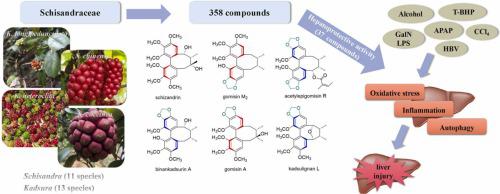Pharmacological Research ( IF 9.1 ) Pub Date : 2023-07-28 , DOI: 10.1016/j.phrs.2023.106872 Shi-Qi Liu 1 , Yu-Pei Yang 1 , Nusrat Hussain 2 , Yu-Qing Jian 1 , Bin Li 1 , Yi-Xing Qiu 1 , Huang-He Yu 1 , Hui-Zhen Wang 1 , Wei Wang 1

|
Liver injury is a common pathological process characterized by massive degeneration and abnormal death of liver cells. With increase in dead cells and necrosis, liver injury eventually leads to nonalcoholic fatty liver disease (NAFLD), hepatic fibrosis, and even hepatocellular carcinoma (HCC). Consequently, it is necessary to treat liver injury and to prevent its progression. The drug Bicylol is widely employed in China to treat chronic hepatitis B virus (HBV) and has therapeutic potential for liver injury. It is the derivative of dibenzocyclooctadiene lignans extracted from Schisandra chinensis (SC). The Schisandraceae family is a rich source of dibenzocyclooctadiene lignans, which possesses potential liver protective activity. This study aimed to comprehensively summarize the phytochemistry, structure-activity relationship and molecular mechanisms underlying the liver protective activities of dibenzocyclooctadiene lignans from the Schisandraceae family. Here, we had discussed the analysis of absorption or permeation properties of 358 compounds based on Lipinski’s rule of five. So far, 358 dibenzocyclooctadiene lignans have been reported, with 37 of them exhibited hepatoprotective effects. The molecular mechanism of the active compounds mainly involves antioxidative stress, anti-inflammation and autophagy through Kelch-like ECH-associating protein 1/nuclear factor erythroid 2 related factor 2/antioxidant response element (Keap1/Nrf2/ARE), nuclear factor kappa B (NF-кB), and transforming growth factor β (TGF-β)/Smad 2/3 signaling pathways. This review is expected to provide scientific ideas for future research related to developing and utilizing the dibenzocyclooctadiene lignans from Schisandraceae family.


















































 京公网安备 11010802027423号
京公网安备 11010802027423号